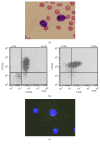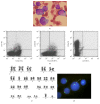Acute Myeloid Leukemia with Basophilic Differentiation Transformed from Myelodysplastic Syndrome
- PMID: 28428897
- PMCID: PMC5385891
- DOI: 10.1155/2017/4695491
Acute Myeloid Leukemia with Basophilic Differentiation Transformed from Myelodysplastic Syndrome
Abstract
Myelodysplastic syndrome (MDS) terminally transforms to acute myeloid leukemia (AML) or bone marrow failure syndrome, but acute myeloid leukemia with basophilic differentiation has been rarely reported. An 81-year-old man was referred to our department for further examination of intermittent fever and normocytic anemia during immunosuppressive treatment. Chromosomal analysis showed additional abnormalities involving chromosome 7. He was diagnosed as having MDS. At the time of diagnosis, basophils had not proliferated in the bone marrow. However, his anemia and thrombocytopenia rapidly worsened with the appearance of peripheral basophilia three months later. He was diagnosed as having AML with basophilic differentiation transformed from MDS. At that time, monosomy 7 was detected by chromosomal analysis. We found that basophils can be confirmed on the basis of the positivity for CD203c and CD294 by flow cytometric analysis. We also found by cytogenetic analysis that basophils were derived from myeloblasts. He refused any chemotherapy and became transfusion-dependent. He died nine months after the transformation. We should keep in mind that MDS could transform to AML with basophilic differentiation when peripheral basophilia in addition to myeloblasts develops in patients with MDS.
Conflict of interest statement
The authors declare no conflict of interests.
Figures


Similar articles
-
Therapy-related myelodysplastic syndrome with monosomy 5 after successful treatment of acute myeloid leukemia (M2).Am J Hematol. 2005 Jun;79(2):136-41. doi: 10.1002/ajh.20329. Am J Hematol. 2005. PMID: 15929101 Review.
-
Physician Education: Myelodysplastic Syndrome.Oncologist. 1996;1(4):284-287. Oncologist. 1996. PMID: 10388004
-
Myelodysplastic syndrome, juvenile myelomonocytic leukemia, and acute myeloid leukemia associated with complete or partial monosomy 7. European Working Group on MDS in Childhood (EWOG-MDS).Leukemia. 1999 Mar;13(3):376-85. doi: 10.1038/sj.leu.2401342. Leukemia. 1999. PMID: 10086728
-
An abnormal clone with monosomy 7 and trisomy 21 in the bone marrow of a child with congenital agranulocytosis (Kostmann disease) treated with granulocyte colony-stimulating factor. Evolution towards myelodysplastic syndrome and acute basophilic leukemia.Cancer Genet Cytogenet. 1995 Oct 15;84(2):99-104. doi: 10.1016/0165-4608(95)00095-x. Cancer Genet Cytogenet. 1995. PMID: 8536230
-
Transformation of myelodysplastic syndrome to acute lymphoblastic leukemia: a case report and review of the literature.Int J Hematol. 2004 Feb;79(2):147-51. doi: 10.1532/ijh97.03137. Int J Hematol. 2004. PMID: 15005342 Review.
Cited by
-
Monoblastic leukemia (M5a) with chronic basophilic leukemia in a cat.J Vet Med Sci. 2022 Feb 23;84(2):251-256. doi: 10.1292/jvms.21-0383. Epub 2021 Dec 15. J Vet Med Sci. 2022. PMID: 34911870 Free PMC article.
References
-
- Brunning R. D., Orazi A., Germing U., et al. WHO Classification of Tumors of Haematopoietic and Lymphoid Tissues. Lyon, France: IARC; 2008. Myelodysplastic syndrome/neoplasms, overview; pp. 88–93.
-
- Arber D. A., Brunning R. D., Orazi A., et al. WHO Classification of Tumors of Haematopoietic and Lymphoid Tissues. Lyon, France: IARC; 2008. Acute myeloid leukemia, not otherwise specified; pp. 130–139.
Publication types
LinkOut - more resources
Full Text Sources
Other Literature Sources
Research Materials
Miscellaneous

